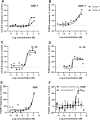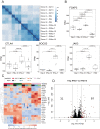Secretome screening reveals immunomodulating functions of IFNα-7, PAP and GDF-7 on regulatory T-cells
- PMID: 34408239
- PMCID: PMC8373891
- DOI: 10.1038/s41598-021-96184-z
Secretome screening reveals immunomodulating functions of IFNα-7, PAP and GDF-7 on regulatory T-cells
Abstract
Regulatory T cells (Tregs) are the key cells regulating peripheral autoreactive T lymphocytes. Tregs exert their function by suppressing effector T cells. Tregs have been shown to play essential roles in the control of a variety of physiological and pathological immune responses. However, Tregs are unstable and can lose the expression of FOXP3 and suppressive functions as a consequence of outer stimuli. Available literature suggests that secreted proteins regulate Treg functional states, such as differentiation, proliferation and suppressive function. Identification of secreted proteins that affect Treg cell function are highly interesting for both therapeutic and diagnostic purposes in either hyperactive or immunosuppressed populations. Here, we report a phenotypic screening of a human secretome library in human Treg cells utilising a high throughput flow cytometry technology. Screening a library of 575 secreted proteins allowed us to identify proteins stabilising or destabilising the Treg phenotype as suggested by changes in expression of Treg marker proteins FOXP3 and/or CTLA4. Four proteins including GDF-7, IL-10, PAP and IFNα-7 were identified as positive regulators that increased FOXP3 and/or CTLA4 expression. PAP is a phosphatase. A catalytic-dead version of the protein did not induce an increase in FOXP3 expression. Ten interferon proteins were identified as negative regulators that reduced the expression of both CTLA4 and FOXP3, without affecting cell viability. A transcriptomics analysis supported the differential effect on Tregs of IFNα-7 versus other IFNα proteins, indicating differences in JAK/STAT signaling. A conformational model experiment confirmed a tenfold reduction in IFNAR-mediated ISG transcription for IFNα-7 compared to IFNα-10. This further strengthened the theory of a shift in downstream messaging upon external stimulation. As a summary, we have identified four positive regulators of FOXP3 and/or CTLA4 expression. Further exploration of these Treg modulators and their method of action has the potential to aid the discovery of novel therapies for both autoimmune and infectious diseases as well as for cancer.
© 2021. The Author(s).
Conflict of interest statement
MD, RM, TO, JB, UG, EB, BM, DRT, II, KFS, LMM, RD and LHS are employees of AstraZeneca. The authors have no additional financial interests. ML, AM, HT, SH, MU and JR declare no competing financial interests.
Figures





References
Publication types
MeSH terms
Substances
LinkOut - more resources
Full Text Sources
Molecular Biology Databases
Research Materials

